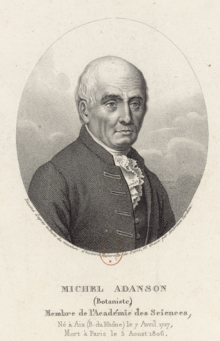Asimina
Asimina has large simple leaves and large fruit. It is native to eastern North America and collectively referred to as pawpaw. The genus includes the widespread common pawpaw Asimina triloba, which bears the largest edible fruit indigenous to the United States.[4] Pawpaws are native to 26 states of the U.S. and to Ontario in Canada.[4][5] The common pawpaw is a patch-forming (clonal) understory tree found in well-drained, deep, fertile bottomland and hilly upland habitat. Pawpaws are in the same plant family (Annonaceae) as the custard-apple, cherimoya, sweetsop, soursop, and ylang-ylang;[6] the genus is the only member of that family not confined to the tropics.
The genus name Asimina was first described and named by Michel Adanson, a French naturalist of Scottish descent. The name is adapted from the Native American name assimin[7] through the French colonial asiminier.[8]
The common name (American) pawpaw, also spelled paw paw, paw-paw, and papaw, probably derives from the Spanish papaya, perhaps because of the superficial similarity of their fruits.[9]
Pawpaws are shrubs or small trees to 2–12 m (6.6–39.4 ft) tall. The northern, cold-tolerant common pawpaw (Asimina triloba) is deciduous, while the southern species are often evergreen.
The leaves are alternate, obovate, entire, 20–35 cm (7.9–13.8 in) long and 10–15 cm (3.9–5.9 in) broad.
The flowers of pawpaws are produced singly or in clusters of up to eight together; they are large, 4–6 cm across, perfect, with three sepals and six petals (three large outer petals, three smaller inner petals). The petal color varies from white to purple or red-brown.



